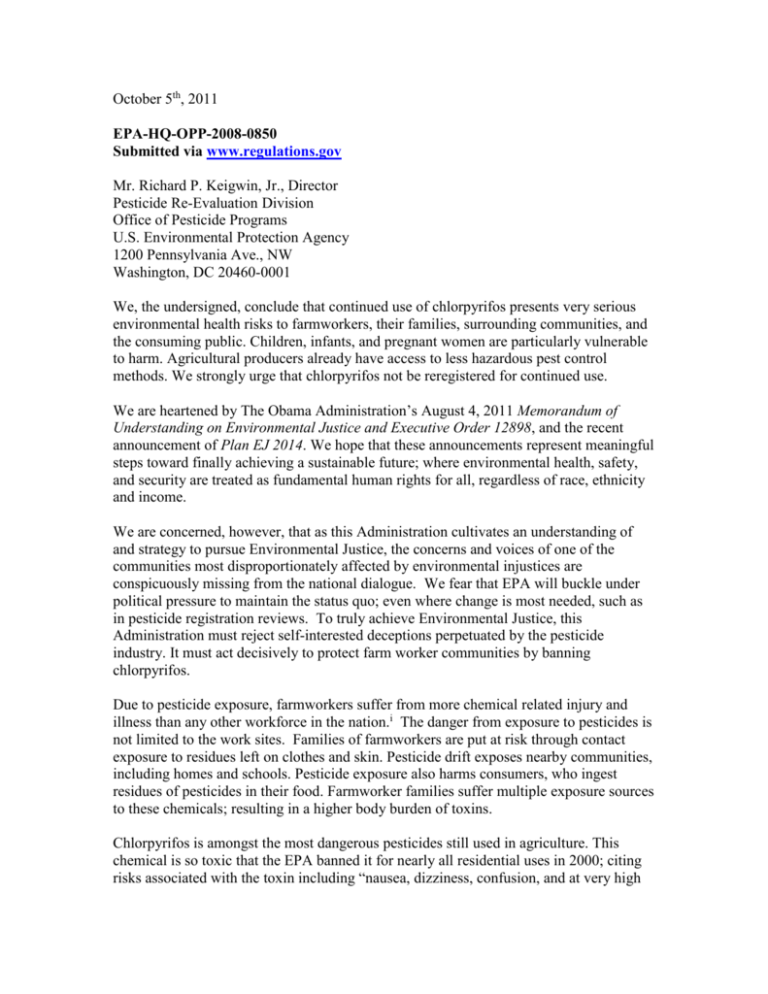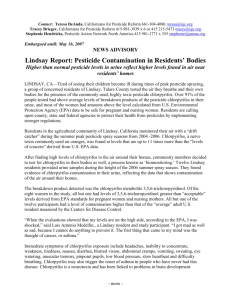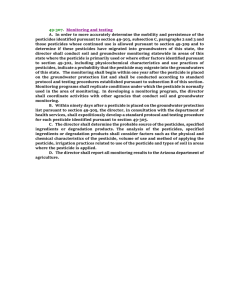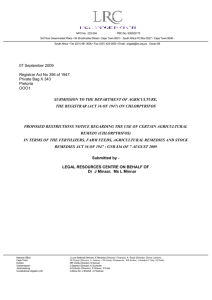We are heartened and inspired by the historic August 4th signing of
advertisement

October 5th, 2011 EPA-HQ-OPP-2008-0850 Submitted via www.regulations.gov Mr. Richard P. Keigwin, Jr., Director Pesticide Re-Evaluation Division Office of Pesticide Programs U.S. Environmental Protection Agency 1200 Pennsylvania Ave., NW Washington, DC 20460-0001 We, the undersigned, conclude that continued use of chlorpyrifos presents very serious environmental health risks to farmworkers, their families, surrounding communities, and the consuming public. Children, infants, and pregnant women are particularly vulnerable to harm. Agricultural producers already have access to less hazardous pest control methods. We strongly urge that chlorpyrifos not be reregistered for continued use. We are heartened by The Obama Administration’s August 4, 2011 Memorandum of Understanding on Environmental Justice and Executive Order 12898, and the recent announcement of Plan EJ 2014. We hope that these announcements represent meaningful steps toward finally achieving a sustainable future; where environmental health, safety, and security are treated as fundamental human rights for all, regardless of race, ethnicity and income. We are concerned, however, that as this Administration cultivates an understanding of and strategy to pursue Environmental Justice, the concerns and voices of one of the communities most disproportionately affected by environmental injustices are conspicuously missing from the national dialogue. We fear that EPA will buckle under political pressure to maintain the status quo; even where change is most needed, such as in pesticide registration reviews. To truly achieve Environmental Justice, this Administration must reject self-interested deceptions perpetuated by the pesticide industry. It must act decisively to protect farm worker communities by banning chlorpyrifos. Due to pesticide exposure, farmworkers suffer from more chemical related injury and illness than any other workforce in the nation.i The danger from exposure to pesticides is not limited to the work sites. Families of farmworkers are put at risk through contact exposure to residues left on clothes and skin. Pesticide drift exposes nearby communities, including homes and schools. Pesticide exposure also harms consumers, who ingest residues of pesticides in their food. Farmworker families suffer multiple exposure sources to these chemicals; resulting in a higher body burden of toxins. Chlorpyrifos is amongst the most dangerous pesticides still used in agriculture. This chemical is so toxic that the EPA banned it for nearly all residential uses in 2000; citing risks associated with the toxin including “nausea, dizziness, confusion, and at very high exposures, respiratory paralysis and death.”ii However, it is still permitted and widely used for agricultural purposes.iii Chlorpyrifos is now known to be even more dangerous than was previously believed at the time of the EPA action. Recent studies have revealed links to lung cancer,iv birth defects,v neurological impairment,vi developmental delay,vii and acute poisoning.viii Despite these widely known dangers, recognized as too great to allow chlorpyrifos into our homes for residential purposes, farmworkers remain exposed to this hazardous chemical. Many farmworkers are exposed when handling and applying chlorpyrifos products. Many more are exposed through direct skin contact with residue left on crops and in the soil. Farmworkers are also subjected to exposure through inhalation when there is pesticide drift from application areas toward nearby fields and other areas where workers are present, including in their homes. Farmworkers unintentionally expose their families with residues left on their clothes and bodies. This type of exposure can be chronic and on-going, as chlorpyrifos can linger in house dust for many years.ix The extent to which farmworkers and their families continue to be exposed to this toxic chemical is well documented. Sampling tests found chlorpyrifos contamination of the air, soil, house dust, and even in blood and urine samples of farmworker communities.x Exposure to this toxic chemical is particularly harmful to children, who have a reduced ability to detoxify the poison.xi The damage caused by chlorpyrifos begins in the womb, and can have profound effects on a child’s development. Studies in New York City that contributed to the decision to ban chlorpyrifos from homes linked prenatal exposure to low birth weight, significant physical and mental developmental delays, and attention deficit disorder.xii Similar studies found that pregnant farmworkers experienced the same, and in many cases higher, amounts of chlorpyrifos exposure as the women surveyed in New York.xiii Many farmworker communities face these same high exposure rates today, ten years after chlorpyrifos was taken off the shelves for use in our homes.xiv Despite these hazards, approximately 10 million pounds of chlorpyrifos are applied in US fields every year.xv It is applied on a wide variety of popular fruits and vegetables; including corn, broccoli, peanuts, tomatoes, onions, lemons, oranges, pears, grapes, cherries, blueberries, and apples. It is also used in the ornamental plant industry. xvi This widespread use, combined with studies showing that the health hazards of chlorpyrifos can affect people whose only exposure is through their food, mean that the dangers posed by this toxin extend from the field to the plate.xvii Over a decade has passed since the EPA took action to protect families from the potentially lethal health effects of chlorpyrifos in our homes. Since that time, new data has revealed that the full extent of the danger is far greater than first realized. Yet the men, women, and children who cultivate, pick, and distribute our food are regularly exposed to the same, and even higher, levels of this toxin that led to it being banned from our homes. Chlorpyrifos can still be found in the air and soil in farmworker communities. It still contaminates the skin, lungs, and blood of farmworkers and their children across the country. Although the continued use of chlorpyrifos poses a threat to everyone, this is undoubtedly an instance of environmental injustice. Farmworker communities are a vulnerable population, shouldered with an unequal burden of toxic exposure. They deserve the same protection deemed necessary for all other families ten years ago. Continued use of chlorpyrifos in agriculture calls into question the violation of the civil and human rights of the largely ethnic minority farmworker community. We urge you to apply the principles announced in the Environmental Justice Memorandum of Understanding. Ban all remaining uses of chlorpyrifos, and finally put an end to this unequal burden hoist upon those who keep us fed. i Calvert et al., Acute Pesticide Poisoning Among Agricultural Workers in the United States, 1998-2005, American Journal of Industrial Medicine 51:8830898 (2008); Martin Donohoe, MD and Eric Hansen, MD Health Issues of Migrant and Seasonal Farmworkers, Journal of Health Care for the Poor and Underserved, Vol. 14, No.2, p. 157, (2003) ii EPA Chlorpyrifos Revised Risk Assessment and Agreement with Registrants; Office of Prevention, Pesticides and Toxic Substances: Washington, DC (2000) iii EPA, 738-F-01-006, February (2002) iv Lee WJ, et al. Cancer Incidence among Pesticide Applicators exposed to Chlorpyrifos in the Agricultural Health Study, Journal of the National Cancer Institute, 96:1781-1789, 2004 v Curl et al, Evaluation of Take-home Organophosphorous Pesticide Exposure among Agricultural Workers and Their Children, Environ Health Perspect (EHP) 110(12), A787-792, (2002); Fenske et al, Children’s Exposures to Chlorpyrifos and Parathion in an Agricultural Community in Central Washington State, EHP 110(5), 549-553, (2002); Koch et al, Temporal Association of Children’s Pesticide Exposure and Agricultural Spraying: Report of a Longitudinal Biological Monitoring Study” EHP 110(8), 829-833, (2002); Simcox et al, Pesticides in Household Dust and Soil: Exposure Pathways for Children of Agricultural Families, EHP 103(12), 11261134, (1995); Fenske et al, Strategies for Assessing Children’s Organophosphorus Pesticide Exposures in Agricultural Communities, Journal of Exposure Analysis and Environmental Epidemiology, 10, 662-671 (2000) vi Kamel F, et al. Neurologic Symptoms in Licensed Private Pesticide Applicators in the Agricultural Health Study. Environ Health Perspect, 113:877-882. (2005); Rohlman D, et al. Neurobehavioral performance in preschool children from agricultural and nonagricultural communities in Oregon and North Carolina. Neurotoxicology, 26:589-598 (2005); Slotkin, TA. Developmental Neurotoxicity of Organophosphates: A Case Study of Chlorpyrifos, Chapter 21, Toxicology of Organophosphates and Carbamate Compounds (2006) vii Young et al, Association Between In Utero Organophosphate Pesticide Exposure and Abnormal Reflexes in Neonates, Neurotoxicology 26:199-209 (2005); Eskenazi et al, Organophosphate Pesticide Exposure and Neurodevelopment in Young MexicanAmerican Children, EHP; 115:792-798 (2007) viii Calvert et al., Acute Pesticide Poisoning Among Agricultural Workers in the United States, 1998-2005, American Journal of Industrial Medicine 51:8830898 (2008); California Department of Pesticide Regulation Pesticide Illness Reporting System (http://www.cdpr.ca.gov/docs/whs/pisp.htm) ix Stout et al, American Healthy Homes Survey: A National Study of Residential Pesticides Measured from Floor Wipes. Enviro Sci and Technology, accepted March 5, 2009; M. Nishioka et al., Measuring transport of Lawn-applied Herbicide Acids from Turf to Home: Correlation of Dislodgeable 2,4-D Turf Residues with Carpet Residues and Carpet Surface Residues, Env. SCI Technol. 30 (1996) Thompson et al, Pesticide Take-Home Pathway among Children of Agricultural Workers: Study Design, Methods and Baseline Findings, J Occup Environ Med, 45:42-53, (2003); Curl et al, Evaluation of Take-home Organophosphorous Pesticide Exposure among Agricultural Workers and Their Children, Environ Health Perspect (EHP) 110(12), A787-792, (2002); Simcox et al, Pesticides in Household Dust and Soil: Exposure Pathways for Children of Agricultural Families, EHP 103(12), 1126-1134, (1995 Dansereau et al, Poisons on the Wind: Community Air Monitoring for Chlorpyrifos in the Yakima Valley, <http://www.fwpp.org>; (2006); Fenske et al, Organophosphorus Pesticide Air Monitoring Project Final Report, <http://www.doh.wa.gov/ehp/Pest/driftresults.htm> (2009): xi Furlong, CE, et al.. Status of Farmworker Mothers and Children as a Predictor of Organophosphate Sensitivity. Pharmacogenetics and Genomics, Vol 16 No 3: 183-190 (2006); Huen K, et al. Developmental Changes in Enzyme Activity in Young Children and Effects of Polymorphisms. Environ Health Perspect, 117:1632-1638. (2009) xii Perera FP, et al.. Effects of Transplacental Exposure to Environmental Pollutants on Birth Outcomes in a Multiethnic Population, EHP, 111:201-205 (2003); Berkowitz et al.. In Utero Pesticide exposure, Maternal Paraoxonase Activity, and Head Circumference, EHP, 112:388-391 (2004); Rauh VA, et al.. Impact of Prenatal Chlorpyrifos Exposure on Neurodevelopment in the First 3 Years of Life Among Inner-City Children. Pediatrics, 118:e1845-e1859 (2006) xiii Dansereau et al, Poisons on the Wind: Community Air Monitoring for Chlorpyrifos in the Yakima Valley, http://www.fwpp.org; (2006); Fenske et al, Organophosphorus Pesticide Air Monitoring Project Final Report, (2009): xiv Richard Knox, Mothers Pesticide Exposure Linked to Kids’ IQs, All Things Considered, National Public Radio, April 21,2011 xv EPA, Chlorpyrifos Facts < http://www.epa.gov/oppsrrd1/REDs/factsheets/chlorpyrifos_fs.htm> xvi National Agricultural Statistics Service, Agricultural Chemical Use Database <http://www.pestmanagement.info/nass/act_dsp_usage_multiple.cfm> xvii Chensheng LC, et al. Dietary Intake and Its Contribution to Longitudinal Organophosphorus Pesticide Exposure in Urban/Suburban Children. Environ Health Perspect 116: 537-542. (2008) Respectfully, Brian Brotman Director Farmworker Health and Safety Institute P.O. Box 510, 4 South Delsea Drive Glassboro, NJ 08028 (856) 881 2507 fhsinj@aol.com Robina Suwol Executive Director California Safe Schools Los Angeles, California (818) 785 5515 www.calisafe.org Margaret Reeves, PH.D. Senior Scientist Pesticide Action Network North America 49 Powell St., Suite 500 San Fransisco, CA 94102 (415) 981-1771 mreeves@aol.com Aimee Code, M.S. Environmental Health Associate Northwest Center for Alternatives to Pesticides P.O. Box 1393, Eugene Oregon 97440-1393 (541) 344-5044 ex.27 acode@pesticide.org Lewis Papenfuse Executive Director Farmworker Legal Services of NY, Inc. 1187 Culver Road Rochester, NY 14609-5448 (585) 269 9639 lpapenfuse@wnylc.com Jeannie Economos Pesticide Safety and Environmental Health Project Coordinator Farmworker Association of Florida 1264 Apopka Boulevard Apopka, Florida 32703 (407) 886 5151 farmworkerassoc@aol.com Nelson Carrasquillo Executive Director El Comité de Apoya a Los Trabajadores Agrícolas (The Farmworker Support Committee) 4 South Delsea Drive Glassboro, New Jersey 08028 (856) 881 2507 catanc@aol.com Virginia Ruiz Senior Attorney Farmworker Justice 1126 16th Street NW, Suite 270 Washington, DC 20036 (202) 293 5420 vruiz@farmworkerjustice.org Margarita Romo Executive Director Farmworker Self Help 37240 Calle De Milagros Dade City, Florida 33523 (352) 567 1432 room@fshflorida.org John C. Philo Legal Director Maurice and Jane Sugar Law Center for Economic and Social Justice 4605 Cass Ave. Detroit, Michigan 48201 (313) 993 4505 jphilo@sugarlaw.org Virginia Nesmith Executive Director National Farm Worker Ministry 438 North Skinker Boulevard St. Louis, Missouri 63130 (314) 726 6470 vnesmith@nfwm.org Denise Diaz Director Central Florida Jobs with Justice 231 Colonial Drive, Suite 150 Orlando, Florida 32801 (407) 849 1799 centralfljwj@gmail.com Anne Katten Pesticide and Work Safety Project Director California Rural Legal Assistance Foundation 2210 K Street, Suite 201 Sacramento, California 95810 (916) 446 7904 akatten@crlaf.org Mitzi Shpak Executive Director Action Now 2062 Lewis Avenue Altadena, California 91001 msmshpak@gmail.com Sarah Aird and Tracey Brieger Co-Directors Californians for Pesticide Reform 49 Powell St., Suite 530 San Francisco, California 94102 (415) 981 3939 tracey@pesticidereform.org Melinda Wiggins Executive Director Student Action with Farmworkers 1317 W. Pettigrew Street Durham, North Carolina 27705 (919) 660 2652 Nadeen.Bir@Duke.edu Alice Freund Industrial Hygienist Mt. Sinai Irving J. Selikoff Center for Occupational and Environmental Medicine 345 East 102nd St. New York, New York, 10029 (212) 241 9054 Alice.Freund@mssm.edu Marty Mesh Executive Director Florida Organic Growers PO 12311 Gainesville, Florida 32604 (352) 377 6345 fog@foginfo.org Karen Otto, Program Administrator Dr. Rathin Vora, Medical Director Finger Lakes Occupational Health Services University of Rochester 2180 S. Clinton Avenue, Suite D Rochester, New York 14618 (585) 244-4771 Ext. 212 Karen_Otto@URMC.Rochester.edu Rev. Stephen Copley Chairman Arkansas Committee on Occupational Safety and Health P.O. Box 2441 Little Rock, Arkansas 72203 (501) 626 9220 Scopley438@aol.com Arthur N. Read Executive Director Friends of Farmworkers, Inc. 42 South 15th St., Suite 605 Philadelphia, Pennsylvania 19102-2205 (212) 733 0878 aread@friendsfw.org Dean Hubbard and Polly Halfkenny Co-Chairs Labor and Employment Committee of the National Lawyers Guild 55 Harrison St., #400 Oakland, CA 94607 (203) 216 2262 (347) 453 5208 DeanHub@gmail.com PollyHalf43@gmail.com Justin Feldman MPH, MSW Worker Health and Safety Advocate Public Citizen 215 Pennsylvania Avenue, SE Washington, DC 20003 (202) 454 5151 JFeldman@citizen.org Arlene Blum, PHD Executive Director Green Science Policy Institute PO Box 5455 Berkeley, CA 94705 Arlene@arleneblum.com Elizabeth Crowe Director Kentucky Environmental Foundation PO Box 467 Berea, Kentucky 40403 (869) 986 08068 Elizabeth@kyenvironmentalfoundation.org Linda A. Cocchiarella, MD, MSc, CAc Medical Director The Long Island Occupational and Environmental Health Center 1741-B North Ocean Avenue Medford, New York, 11763 (631) 289 1405 Linda.Cocchiarella@stonybrook.edu Barbara Rahke Director Philadelphia Area Project on Occupational Health and Safety 3001 Walnut Street, 5th Floor Philadelphia, Pennsylvania 19104 (215) 386 7000 Philaposh@aol.com Beth Rosenberg, ScD, MPH Assistant Professor Department of Public Health and Community Medicine Tufts University School of Medicine 136 Harrison Avenue Boston, Massachussets 02111 (617) 636 6651 Beth.Rosenberg@tufts.edu Erin Switalkski Executive Director Women’s Voices for the Earth 114 W. Pine Street, PO Box 8743 Missoula, Montana 59807 (406) 543 3747 Jamies@womensvoices.org Rick Hind Legislative Director Greenpeace 702 H Street, NW #300 Washington, DC 20001 (202) 319 2445 Rick.Hing@greenpeace.org Michael C. Fitts Executive Director Connecticut Coalition on Occupational Safety and Health 683 North Mountain Road Newington, Connecticut 06111 (860) 953 2674 Mike.ctcosh@snet.net Pamela K. Miller Executive Director Alaska Community Action on Toxics 505 West Northern Lights Boulevard, Suite 205 Anchorage, Alaska 99503 (907) 222 7714 pamela@akaction.org Judith Robinson Associate Director Environmental Health Fund 41 Oakview Terrace Jamaica Plain, Boston Massachusetts 02130 (802) 251 0203 jrobinson@igc.org Rachel Lincoln Sarnoff Executive Director/CEO Healthy Child, Healthy World 12300 Wilshire Boulevard #320 Los Angeles, California 90025 (310) 820 2030 x.112 Lynn Thorp National Campaigns Coordinator Clean Water Action 1010 Vermont Ave NW 4th Floor Washington, DC 20005 (202) 895 0420 ext. 109 Reid Maki Director of Social Responsibility and Fair Labor Standards, Child Labor Coalition National Consumers League 1701 K Street, NW, Suite 1200 Washington, DC 20006 (202) 207 2820 reidm@nclnet.org Kathleen A. Curtis, LPN Executive Director Clean and Healthy New York 62 Grand Street Albany, NY 12207 518-708-3922 Clean.Kathy@gmail.com Jim Harkness President Institute for Agriculture and Trade Policy 2105 1st Avenue, South Minneapolis, Minnesota 55404 (612) 870 0453 Lin Kaatz Chary, PhD, MPH Director Indiana Toxics Action 7726 Locust Avenue Gary, Indiana 46403 (219) 938 0209 lchary@sbcglobal.net Peter Dooley MS, CIH, CSP Director LaborSafe Health and Safety Consulting 6301 Zeeb Road Dexter, Michigan 48130 laborsafe@aol.com Joann Lo Executive Director Food Chain Workers Alliance 634 S. Spring Street, #614 Los Angeles, California 90014 (213) 489 9054 joann@foodchainworkers.org Judy Gearhart Executive Director International Labor Rights Forum 1634 I Street NW, Suite 1001 Washington, DC 20006 (202) 347 4100 x106 judy@irlf.org Sue Phelan Director GreenCAPE P.O. Box 631 West Barnstable, Massachusetts 02668 (508) 362 5927 suephelan@comcast.net Barbara Gottlieb Director, Environment and Health Physicians for Social Responsibility 1875 Connecticut Ave. NW, Suite 1012 Washington, DC 20009 (202) 587 5225 bgottlieb@psr.org Cecil Corbin-Mark Deputy Director WE ACT for Environmental Justice 1854 Amsterdam Avenue New York, New York 10031 (212) 961 1000 x.303 Cecil@weact.org Juan Parras Director Texas Environmental Justice Advocacy Services 6733 Harrisburg Houston, Texas 77011 (281) 513 7799 Parras.Juan@gmail.com Kerstin Lindgren Executive Director Domestic Fair Trade Association PO Box 300190 Boston, Massachusetts 02130 (617) 680 9862 kerstin@thedfta.org Robynn Shrader CEO National Cooperative Grocers Association 14 South Linn Street Iowa City, Iowa 52240 (319) 466 9029 Monique Harden & Nathalie Walker Co-Directors, Attorneys Advocates for Environmental Human Rights 650 Poydras Street, Suite 2523 New Orleans, Louisiana 70130 (504) 799 3060 mharden@ehumanrights.org nwalker@ehumanrights.org Rosalinda Guillen Executive Director Community to Community Development 203 W. Holly, Suite 317 Bellingham, Washington 98233 (360) 738 0893 rosalindag@qwestoffice.net Ernesto Velez Bustos Director Centro Campesino, Inc 216 N. Oak Avenue Owatonna, Minnesota 55060 (507) 446 9599 info@centrocampesino.net











